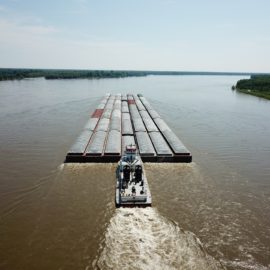
The Corps of Engineers in Slidell discussed projects yesterday.
The Army Corps of Engineers is scheduled to make a decision on a Pearl River flood reduction plan that could prevent massive flooding in the Jackson, Mississippi, area, but it’s raised a number of concerns downriver in Louisiana. During a public meeting in Slidell Tuesday, the corps discussed proposed flooding solutions and gathered additional public input to be considered in a final environmental impact statement that will guide a decision. Corps representatives presented a combination of flood risk management plans as identified by the Rankin-Hinds Flood Control and Drainage District, the Jackson-based public agency that has pushed for flood improvements in central Mississippi. The plan preferred by the district, known as “One Lake,” calls for dredging and widening portions of the Pearl River in Mississippi, and removing an existing dam while rebuilding a larger one downstream. The proposed, $342 million plan would also upgrade an existing levee into a federally controlled ring levee around a wastewater treatment plant that has been blamed for releasing millions of gallons of wastewater into the river between 2020-2022.
nola.com
A lake would be formed but that is where Louisiana comes in.
A portion of the Pearl River would also become an 1,800-acre lake, a move that has stirred much controversy and opposition from environmental activists, elected officials and residents downriver, particularly in St. Tammany Parish. One of the chief worries downstream is that the dam will choke the flow of water into Louisiana, wrecking the ecology of the Pearl River Basin. During Tuesday’s meeting in Slidell, several audience members voiced concerns that real estate development is driving the One Lake project, not flood control. “They’re already advertising lots in the Jackson area,” said John Gattenberg of New Orleans. Gattenberg asked if increased land and property values associated with the new lake would be dispersed to those displaced by the project. Robin Colosimo of the Corps said the agency isn’t looking to make investments that drive people away from their homes. Other concerns raised by audience members included the impact on wetlands, further disruption to ecosystems and the shrimp, crab, and oyster industry, risk of storm surge, and a history of abandoned infrastructure projects — dams and lock systems that have sat in disarray for years. “I just think instead of building more things, the U.S Army Corps of Engineers should take care of what they’ve already built in the Pearl River Basin instead of constructing more problems,” said Janice O’Berry of Pearl River.
Some say the river is no more than a ditch.
O’Berry also said that “common sense” measures are being overlooked. Comparing the Pearl River to a 414-mile ditch, O’Berry said the river is full of debris and needs to be cleaned in order to drain and flow properly. “The Pearl is nothing but a big ditch and down here, that ditch is clogged up,” she said. In response, Colosimo said infrastructure maintenance is a problem nationwide “in every aspect of government.” Alternatives to the One Lake plan include buying out and relocating over 3,000 homes, businesses, schools, and other structures that pose the greatest risk for flooding as well as investing in elevation and flood proofing measures. The Corps states in the Federal Register that while this option would bring the least impact to natural resources, it would have a significant impact on housing, employment, and economic growth. The public has until June 20 to submit comments with a final report expected to be completed by December.
More than a ditch and the lake sounds like a gift to developers.



